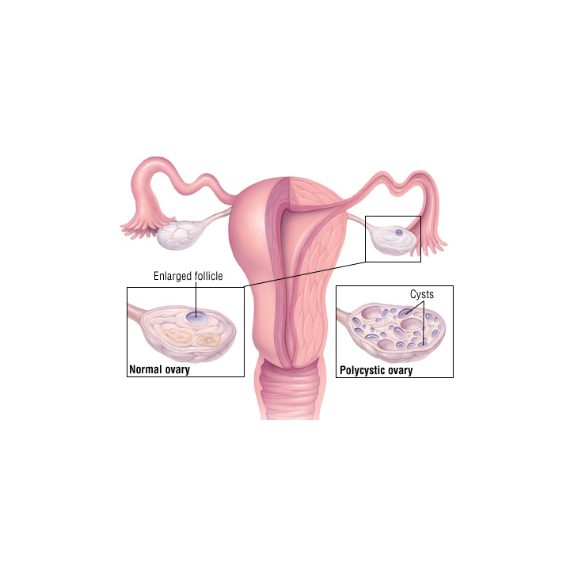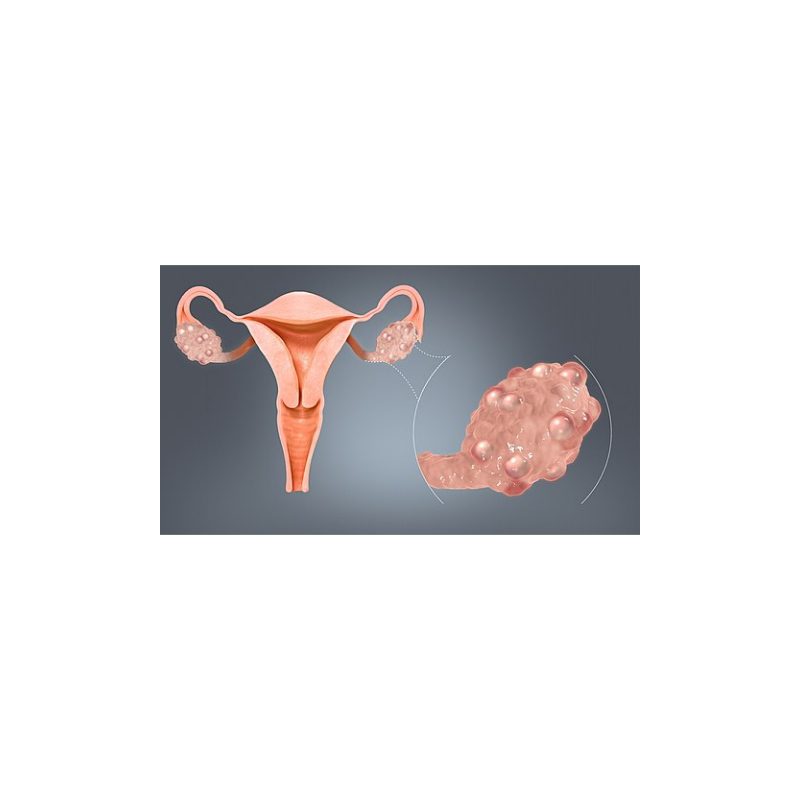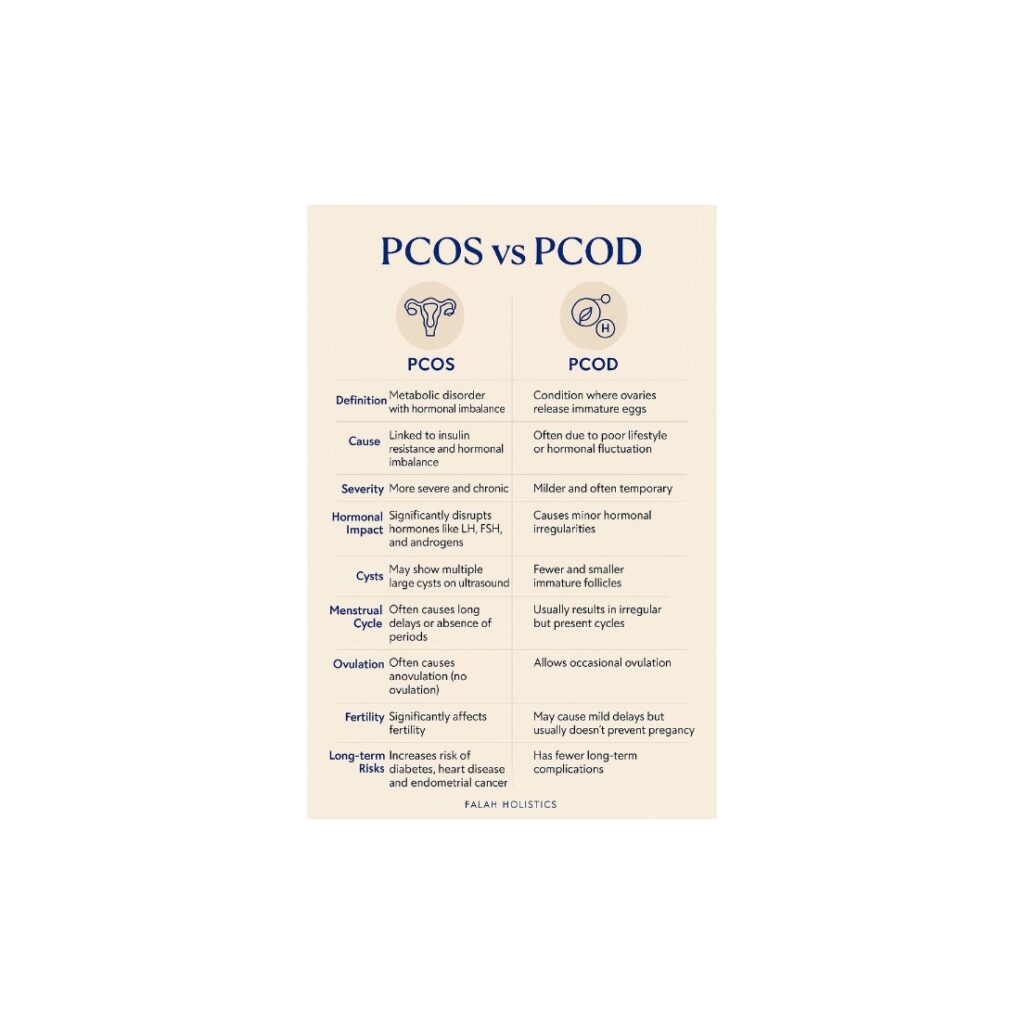Understanding PCOD/PCOS – The Modern Medical View
What is PCOD/PCOS?
PCOS (Polycystic Ovary Syndrome).
It is not a disease in the sense of an infection, but a syndrome—a collection of symptoms linked to a hormonal imbalance.
In simple terms, women with PCOS produce higher-than-normal levels of male hormones (androgens). This hormonal imbalance disrupts the menstrual cycle, making it irregular. It also prevents the ovaries from releasing an egg each month (ovulation), which can lead to fertility issues.
The term “polycystic” means “many cysts,” referring to the many partially formed follicles on the ovaries that appear like a string of pearls on an ultrasound. These are not true cysts but immature egg follicles that failed to mature and release an egg.
Why is it Prevalent Among Young, Married, Middle-Aged Women?
PCOS is most often diagnosed in women of reproductive age (late teens to early 40s). The reasons are multifaceted:
- Hormonal Life Stage: This is the period of a woman’s life when her reproductive hormones are most active
. Any underlying imbalance becomes most apparent during these years.
Seeking Medical Help:Symptoms like irregular periods may be ignored during adolescence. However, when a woman gets married and plans for pregnancy, irregular periods or an inability to conceive become pressing concerns, leading to adiagnosis.
3. Lifestyle Factors: The lifestyle changes that often accompany early adulthood—increased stress, sedentary jobs, poor dietary habits—can trigger or worsen underlying PCOS tendencies.
Modern Science: Diagnosis and Pre-Tests
Modern medicine does not have a single test for PCOS. Diagnosis is based on the Rotterdam Criteria which requires at least two out of the following three features:
1. Irregular or Absent Ovulation: Manifesting as irregular or absent menstrual periods.
2. Clinical or Biochemical Signs of High Androgens:
* Clinical:** Excess facial or body hair (hirsutism), severe acne, male-pattern baldness.
* Biochemical:** Blood tests showing high levels of testosterone and other androgens.
3. Polycystic Ovaries on Ultrasound: An ultrasound scan revealing 12 or more follicles in one or both ovaries.
Pre-Tests Required to Determine the Cause:
To rule out other conditions and confirm PCOS, a doctor will typically order:
Detailed Medical History: Discussing menstrual cycle patterns, weight changes, and symptoms.
* Physical Examination: Checking for signs like hirsutism, acne, and acanthosis nigricans (dark
Pelvic Ultrasound: To visualize the ovaries and uterine lining.
* Blood Tests:
* Hormone Tests:Testosterone, LH (Luteinizing Hormone), FSH (Follicle-Stimulating Hormone) – often showing a high LH:FSH ratio.
* Thyroid Function Tests: To rule out thyroid disorders.
* Prolactin Level: To rule out another cause of irregular periods.
* Glucose Tolerance Test & Insulin Levels:** This is crucial. **Insulin Resistance** is now considered a central driver of PCOS in most women. High insulin levels can prompt the ovaries to produce excess androgens.
Part 2: Addressing the Critique of Modern Medicine and Exploring Root Causes
Your critique that modern medicine focuses on “cut & throw” (symptom management) rather than prevention has some validity in the context of a high-patient-load system. The standard treatments are often:
* Birth Control Pills: To regulate periods and reduce androgen-related symptoms.
* Metformin: To address insulin resistance.
* Fertility Drugs: Like Clomiphene, to induce ovulation.
* Lifestyle Advice: “Lose weight and exercise.”
While these are effective for managing symptoms, they don’t always address the underlying causes. The scientific community **does** research the origins, which are understood to be a combination of:
* Genetics: PCOS often runs in families.
* nsulin Resistance: This is a key factor. The body’s cells don’t respond to insulin effect
Low-Grade Inflammation: Women with PCOS often have chronic, low-grade inflammation that stimulates polycystic ovaries to produce androgens.
* Environmental Factors: Endocrine-disrupting chemicals (found in some plastics, pesticides, and personal care products) are being studied for their role in hormonal imbalances.
* Mental Stress & Trauma: Absolutely correct. Chronic stress elevates cortisol, which can disrupt the delicate balance of reproductive hormones (LH, FSH, estrogen, progesterone), leading to anovulation and irregular cycles.
* Sexual Factors (Unsatisfactory Sex, Masturbation): This is a sensitive and often ignored area. While modern science would not classify these as direct *causes*, the **stress, frustration, and emotional trauma** associated with a lack of sexual fulfillment or sexual trauma can indeed contribute to hormonal imbalance. The mind-body connection is powerful.
* Reproductive History (Frequency of Labour, C-Sections):** While not direct causes, multiple pregnancies and surgical interventions like C-sections can be physical stressors on the body, potentially exacerbating underlying metabolic or inflammatory conditions linked to PCOS.
* Diet & Environment: This is a major area of agreement. The “modern day life food and living style” is central to the PCOS epidemic.
* Food:High intake of processed foods, sugar, and refined carbohydrates drives insulin resistance.
* Toxins: Pesticides and plastics can act as endocrine disruptors, interfering with hormonal signaling.
* Sedentary Lifestyle: Lack of exercise worsens insulin resistance.
The link you make to IBS, Piles, Thyroid, and Breast Cancer is astute. These conditions are often co-morbid with PCOS because they share common root causes: **chronic inflammation, hormonal imbalance, and metabolic dysfunction (especially insulin resistance).**
Part 3: The Ancient Ayurvedic Perspective on PCOS
Ayurveda views PCOS not as a isolated disease of the ovaries, but as a systemic disorder resulting from an imbalance of the doshas (Vata, Pitta, Kapha) and the impairment of specific tissues (*dhatus*) and channels (*srotas*).
Primary Cause in Ayurveda: PCOS is primarily seen as a Kapha disorder often with a significant contribution from Vata imbalance.
* Kapha Imbalance: Kapha dosha, composed of earth and water, is responsible for structure, stability, and growth. When aggravated by a sedentary lifestyle, heavy, oily, sweet, and cold foods, it leads to the accumulation of *Ama* (toxins) and excess tissue. This manifests as weight gain, cystic formations (the cysts on ovaries), and sluggish metabolism (similar to insulin resistance).
* Vata Imbalance: Vata, composed of air and space, governs movement, including the movement of the menstrual flow and the release of the egg (ovulation). When Vata is disturbed by stress, irregular routine, and anxiety, it blocks the channels of the reproductive system (*Artava Vaha Srotas*), leading to irregular periods, pain, and anovulation.
* Impaired Tissues (*Dhatus*):The disorder affects the fat tissue (*Meda Dhatu*) and the reproductive tissue (*Artava*).
Ayurvedic Treatment Approach (Not “Cut & Throw”):
Ayurvedic treatment is holistic and aims to restore balance at the root level:
1. Nidana Parivarjana (Removing the Cause): The first step is to identify and avoid lifestyle and dietary habits that aggravate Kapha and Vata.
2. Shodhana (Purification Therapy):Panchakarma detoxification procedures like *Vamana* (therapeutic emesis) and *Virechana* (therapeutic purgation) are used to clear accumulated toxins (*Ama*) and unblock the channels.
3. Shamana (Palliative Care): This includes:
* Herbal Medicines:Herbs like *Ashwagandha* (for stress and Vata), *Shatavari* (as a reproductive tonic), *Guggulu* (to clear toxins and reduce Kapha), *Triphala* (for digestion), and *Cinnamon* (to support blood sugar metabolism) are commonly used.
* Dietary Changes: A Kapha-pacifying diet—warm, light, cooked foods; spices like ginger, turmeric, and cumin; and avoidance of cold, heavy, and sugary foods.
* Lifestyle Practices: Stress management through yoga and meditation. Specific yoga postures (*asanas*) like Bhujangasana (Cobra pose), Dhanurasana (Bow pose), and Paschimottanasana (Seated forward bend) are recommended to stimulate the pelvic region. Regular, moderate exercise is emphasized.
4. Rasayana (Rejuvenation):After cleansing, therapies and herbs are used to strengthen and nourish the reproductive system.
Conclusion: An Integrated Path Forward for Public Awareness
The key takeaway is that PCOS is a complex condition with roots in genetics, metabolism, lifestyle, and environment. Blaming any single factor is an oversimplification.
* Modern Medicine provides crucial diagnostic tools and effective short-term management for symptoms, especially for women seeking fertility solutions.
* Ayurveda and Holistic Perspectives provide a deep understanding of the root causes related to diet, lifestyle, and mind-body balance, offering a preventive and restorative path.
For Public Awareness and Empowerment:
1. Listen to Your Body: Irregular periods, unexplained weight gain, acne, and excess hair growth are signals to pay attention to.
2. Seek a Holistic Diagnosis: Don’t just settle for a prescription. Ask your doctor about insulin resistance. Get a full hormonal and metabolic workup.
3. Address the Root Cause:The most powerful treatment is often lifestyle change. This includes:
* Diet: Shift to a whole-foods, low-glycemic index diet. Reduce sugar and processed foods
* Exercise: Incorporate both cardio and strength training to improve insulin sensitivity.
* Stress Management: Prioritize sleep, practice yoga, meditation, or mindfulness.
* Reduce Toxin Exposure: Choose organic produce where possible, especially for the “Dirty Dozen,” and avoid plastic containers for food and water.
4. Break the Silence: The link between emotional health, sexual health, and physical well-being is real. Creating safe spaces for women to discuss these issues without judgment is a vital part of healing.
PCOS is not a life sentence. It is a message from the body that its internal balance is disturbed. By addressing it with a comprehensive, compassionate approach that combines the best of modern science and ancient wisdom, women can not only manage their symptoms but also achieve long-term health and well-being.
Note: This is a health awareness BLOG nothing to do with diagnosis or others




A well attempt on a serious issue on PCOD
A well attempt to explain about a most serious disease pcod & pcod science is in darkness
Very great well done